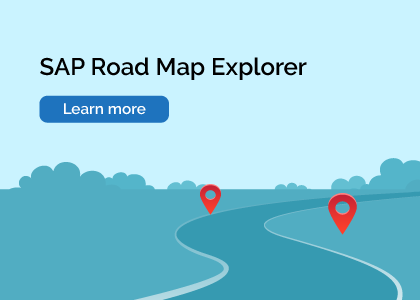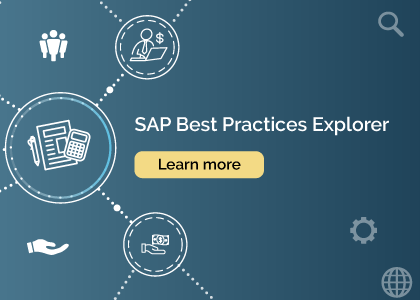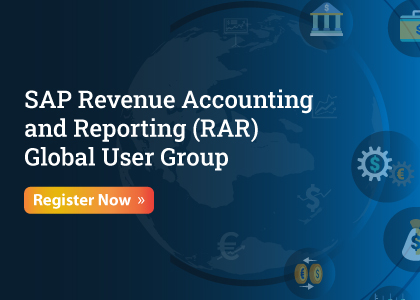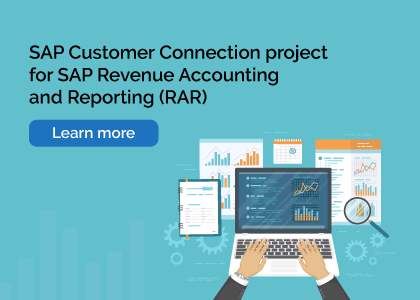Also, below is a transcript of the podcast episode:
Jim Hunt: Hello, this is Jim Hunt for Bramasol’s Insights to Action podcast series. Today, we are lucky to have Pete Graham back. Pete is Director of Finance Solutions and Mobility at SAP. And today we’re going to talk about the benefits of Automated Revenue Management in the cloud. Welcome back, Pete.
Pete Graham: Good to be back.
Jim Hunt: Ok, why don’t we start with kind of an overview of how Automated Revenue Management and the cloud fits in with the overall Comply, Optimize and Transform journey.
Pete Graham: So, just reminding the audience that Automated Revenue Management or ARM as we call it for short, solutions from SAP are really a portfolio covering a wide diversity requirements that we see in the revenue recognition and revenue accounting space. We also see this as a spectrum, that goes from low complexity requirements across low volume and simple accounting, all the way up to high complexity, right? So we call all of this kind of the spectrum in this area. Now with Automated Revenue Management, our brand goal has not changed. It’s to automate and simplify revenue accounting. We believe we’re also introducing better experiences and insights as well as single source of truth. With this portfolio, especially on S/4HANA, we have industrial strength software, that’s solving some of the most complex RevRec challenges worldwide.
Pete Graham: So when you take the ARM piece and now really combine it with other thoughts, one is the Comply, Optimize, Transform methodology. I think that’s a great way for customers to understand exactly where they are along their maturity journey on revenue recognition or Automated Revenue Management capabilities. Again, we’ll talk a little bit more about that, but it’s really a quick way to assess your ARM status and then help chart your next steps. Overlay that with things that we’ve talked with John Froelich about (in previous webinars), there are other dimensions or metrics that really can allow you to better assess your specific requirements. And really, as you measure these, it will help you gain insights as the best fit for which ARM solution from SAP would be good for you.
Pete Graham: (Another technique): These dimensions are Volume, Velocity, Density, and Complexity. Volume is simply the number of transactions or revenue documents that you’re going to be processing. Velocity is the real-time nature of your business, which is the rate of changes that you’re seeing in modifications within your business or revenue recognition that your business encounters. Density, I like to think of this as the number of performance obligations you would be using on any single contract. Usually these are dozens, but we have some customers that have thousands, and thousands. And then complexity, you know, it could be a wide topic, such as complexity of the accounting rules, whether it’s revenue cost, currency, multi-gap, etc. But it can also involve other things like billing or reporting.
Pete Graham: So in general, as you go across these dimensions, Velocity, Volume, Density, Complexity, the higher you move up or measure on these dimensions, it’s probably leaning you toward going to the Private Cloud with RAR on S/4HANA Han and OCM, because it has capabilities for instance, on the density side that allow you to calculate more performance obligations per contract more easily, as well as to combinate higher volumes and real-time processing. Plus, It has an analytics, right? So that you can handle the more complex reporting requirements as well as more complex calculations, like day-based calculations.
Pete Graham: So by combining all these techniques, you have a portfolio of ARM solutions from SAP, you have the Comply, Optimize, Transform methodology, and you have your dimensions, Volume, Velocity, Density, Complexity. By combining all these, you can find the right solution for your ARM journey. First, you would use the COT methodology to figure out where you are and where you want to go. Maybe you’re in the Optimize, or Compliance bucket and you want to move to one of the other buckets, such as Optimize or Transformation. Then you measure your key dimensions across Volume, Velocity, Density, and Complexity. From those, you can do a fit gap, right, and really figure out which is the best match for your requirements, considering your strategic COT goals and your measurements across Volume, Velocity, Density, and Complexity.
Jim Hunt: That’s a great overview. Let’s drill down a bit, if you could talk about the cloud deployment options and how they’re different.
Pete Graham: Sure. So, SAP offers both Public and Private Cloud options on this with S/4HANA, offering different solutions and capabilities for different customer requirements and markets. In the Private Cloud, SAP offers S/4HANA revenue accounting. This is really the RAR solution with OCM, called Optimized Contract Management. On the flip side of that, Public Cloud SAP offers SAP S/4HANA Event-based Revenue Recognition. We also like to call this EBRR. You know, there are benefits for each option. The Private Cloud options I like to think are really good for customers on mixed landscapes that need strong integration or migration capabilities, and then measure high along those areas of Volume, Velocity, Density, and Complexity dimensions, VVDC for short, that we just went through. The Public Cloud options are really good for customers that want kind of out-of-the-box, seamless interoperability very quickly. We’ve seen that with some of our customer success stories our customers that move from older ERP systems, right on to the S/4HANA cloud. Those revenue recognition requirements, especially if they’re related to subscriptions, or professional service industry projects, or sell-from-stock scenarios, are very readily supported by the RevRec methods of EBRR within the S/4HANA public cloud.
Jim Hunt: That’s great. Let’s, dive deeper into Public Cloud capabilities. Maybe you can talk a little bit about EBRR some more in the specific benefits.
Pete Graham: Sure. So, Event Based Revenue Recognition or EBRR is loaded with the S/4HANA Cloud Finance option. And really the benefits around this we can simplify into kind of three buckets. First, it’s real time reporting, right? So you’ve got real time matching of costs and revenues so you have very little reconciliation efforts. For instance, the revenue recognition process is fully integrated into the universal journal, so a lot of those flows are built in, hence reconciliation really is not needed in that example and many other examples. And there’s full transparency, which really comes from the S/4HANA Intelligent Enterprise platform using in-memory technology that HANA offers as well as the universal journal. So you can get full transparency by drilling down into GL accounts, such as revenue or profitability attributes or really any revenue document. And that’s a hallmark capability of the S/4HANA Intelligent Enterprise suite.
Pete Graham: Some other things to think about regarding EBRR are the different revenue recognition methods that are supported. So if we look at professional services, for instance, we have methods that are supported like time and material, percentage of completion with respect to either cost or effort, contract completed dates, and periodic installments. We also have other RevRec scenarios outside professional services, such as sell-from-stock, service documents, project-based sales and project-based services.
Pete Graham: And one note is the best place to search for all this information related to which revenue recognition methods there are is in what we call the SAP Best Practices Explorer. You can just go and search for revenue recognition and you’ll see all of the methods that supported. Also, within that are not only descriptions, but if you dig deep enough, I think it’s just a single extra click, you can actually see test cases and some other more details on each scenario and as well as help support.
Jim Hunt: Great. Thank you. Then how does the Private Cloud compare to that as far as capabilities and benefits?
Pete Graham: That’s a great question. Really, it’s the flip side. We think the Private Cloud has a very capable offering. The core of this is S/4HANA with Optimized Contract Management. Then, because of the platform that you’re on, you’re able to integrate with other systems, whether it’s SAP or non-SAP. Because of the Optimized Contract Management and S/4HANA and the Intelligent Enterprise Platform, you’re actually going to work with the Fiori UI. So there’s a lot of new apps that aren’t available in the old ERP world, but are in Fiori that are very beneficial. You also have the embedded analytics, which is great for reporting, and you have improvements on the real-time operations. That’s kind of in the name Optimized Contract Management. What’s meant there that it’s optimizing different processes, and, in some sense, it’s the real-time nature that really stands out.
Pete Graham: You also have innovation extensions on this offering in the Private Cloud. So if you need to do additional, customizations or unique configurations, you can do it. The platform set up, as we talked about the Volume, Velocity, Density and Complexity metrics, it’s really more efficient at handling high volumes and higher densities or depth of managing higher velocities of changes. It can also handle more complex situations like data-based calculations. With embedded analytics reporting, we’ve recently had a lot of customer success with customers on not only RAR but also combining that with BRIM Billing and Revenue Innovation Management. As we’ve talked in other podcasts and webinars, we’ve seen that this Digital Solutions Economy is bringing more complexity into the business models and business in general. And they’re handling this better with, with the BRIM and RAR combination.
Jim Hunt: So, is it fair to kind of at a high level, characterize them as the Public Cloud is more of an off-the-rack, complete, solution with best practices and you stay current with everything, whereas the Private Cloud is more for those specialized complex situations, maybe involving non-SAP applications and so on, where there needs to be some deep tailoring for the fit.
Pete Graham: Yeah. I think that’s a good way to describe it. I mean, either of the solutions also have some ability to be either simpler or tailored. Like in the Private Cloud, it really reflects the complexity of your requirements, or in the Public Cloud, there are ways to tailor it a little bit. But, I think your, your statement’s accurate, for most customers, that’s probably where I would start. And then as you dig in, you can always see kind of the nuances as you dig into the fit gap of your requirements.
Jim Hunt: Right. And, then part of the decision obviously is the roadmap forward. So maybe you could take the few minutes we have left and discuss what the roadmap for ARM in the cloud looks like.
Pete Graham: Sure. So, the Private Cloud version, OP2021, was just released with many improvements. We won’t go through all of them, but we’ll give you a link to the Roadmap Explorer so you can see where those are. We do have improved decision-making through universal journal based revenue analytics. There’s also a way to do real time postings right into the universal journal, so you don’t necessarily have to go through a sub-ledger to do that. So that’s a nice process improvement as related to always trying to improve the real-time nature of the solution. It can also support intercompany scenarios and manual price allocations due to Optimized Contract Management capabilities. So that’s kind of a good summary of what just came out.
Pete Graham: As we look forward, the next Private Cloud version of OP2022 is planned for next year. And some of the future capabilities that we’re considering are utilizing predictive accounting to improve revenue analytics. We think we’ll be able to look at additional scenario support for revenue accounting, as well as support for revenue recognition and margin analysis for asset-centric service industries. So we have a lot of requests on, once you calculate revenue, what are the margins, and hopefully we’ll get to some improvements in that area.
Pete Graham: As we look at the Public Cloud that also has recently introduced lots of features and this is on a quarterly cycle. So really the best way to keep up with that is go to the best practices Business Explorer link that we talked about, which is updated in real time. We’ve recently introduced support for revenue recognition for periodic services, with new project billing. We have some new Fiori apps that work in process details related to revenue recognition. We’ve added some profit-center extensibility. So you have to go through the list, but there’s lots of things being added every quarter.
Pete Graham: In terms of what’s coming in the future, really in this quarter, we do have some plans to introduce automated impairment processes for closing activities. We also have improvements coming to revenue recognition for usage based billing, sales of non-stock items for the revenue recognition keys, as well as the availability of a new revenue recognition method based on 360 day calendar for service contracts and provider contracts related to subscription billing. So that gives you an idea of some of the things that coming again for full information, check out the Roadmap Explorer, SAP Road Map Explorer search for revenue and cost accounting. And then depending on the product you want, you filter on S/4HANA cloud, that’s really the Public Cloud or S/4HANA 2021 for the Private Cloud.
Jim Hunt: That’s, that’s a great overview of the roadmap. We’ll definitely include a link to the Roadmap Explorer. And, I would assume that, if people want to get their requests in for things to put on the roadmap, being active in the user group would be a great way to do that.
Pete Graham: Yeah, that’s a good way. Then there are some customer connection programs out there as well. There’s one going on right now for ERP (RAR), but yes, the user groups are a great way also to for our customers to get engaged. We do take a market pulse or customer pulse during those meetings just to see what’s going on. So it’s also a great way to, to bring up topics or things that customers think would be improvements for the products.
Jim Hunt: That’s great. Thank you again for your time, Pete. I really appreciate it and I know our listeners will appreciate it too.
Pete Graham: Okay, Jim, no problem. Thanks. Have a great day.




